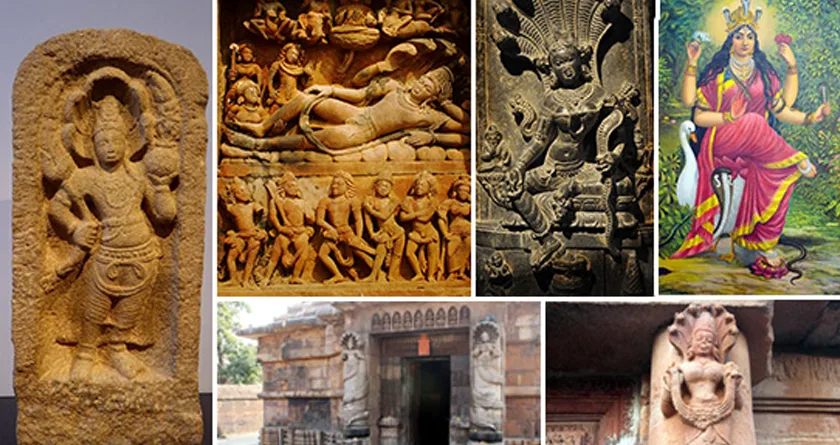
Snake, Nag worship in India
Article tells about origins of snake worship esp. in India, its practice in North, East and South India…Read more…
Monday, 19th April 2021
In the minds of the early men there were a fear of the nature and powerful animals, with a feeling that they were stronger and wiser than him, or in short: uncanny. This was esp. true of the snake or serpent because of its swift, mysterious, yet graceful gliding movements without possessing any feet or wings, it’s fascinating eyes, the power to disappear swiftly, shedding of its skin which gave a sign of immortality, and the deadly consequences of its bite.
All these characteristics produced mixed feelings of fascination, fear and respect, which led to the start of serpent worship, and a subject of many myths and folktales. In the cults that worship animals, such as the Naga cult worshipping serpents, there is generally found among its followers a strong belief in the animal’s magical powers, beneficence, healing powers, wisdom, and the possession of secret higher knowledge.
In the ancient world serpent worship was popular and universally practiced in Arabia, Persia, Asia Minor, Syria, Egypt, Italy, Greece, in many parts of northern and Western Europe, the current Latin American nations, China, Sri Lanka, and Japan.
However, the Naga cult assumed special importance in India, and unlike the other nations it took a more developed form with many interesting variations, and was also more widely distributed. India is also a country which always had a wide distribution of a variety of snakes, and the large number of deaths that took place from their venomous bites explain why the serpents or Nagas were feared, respected, and worshipped from prehistoric era.
Manasa devi, the Goddess of Serpents
There are innumerable references to the Naga worship cult in the ancient Indian scriptures, such as the Vedas, Epics, Sutras and in many other literature.
While the worship of the Naga was in its initial stages in the Rig-Veda, it became a regular object of worship in the Yajurveda, with offerings of various sacrificial items. The Rigvedic term Ahi budhyna, meaning the “serpent of the Deep” could be a representation of an atmospheric deity, with a figurative form of a serpent. Atharvaveda gives more details of the Naga worship and is filled with many charms and incantations against snakes, and also describes a rite for gaining the favour of the Naga devta on the full moon day in the month of Agrah?ya?a/M?rga??ra. Atharvaveda also mentions names of many snake gods (such as Asita, Rabhru, Kairata, Prsna, Apodaka, Taimata, etc) in different contexts, and sometimes associates them with the gandharvas, yaksas (punyajanas), apsaras:
Besides Hinduism, Nagas have also found a place of significance in Buddhism, Jainism, Sikhism, and in other local and regional cults, as clearly evident from their religious monuments, sculptures, paintings, literature, tradition, and folk tales.
The Buddhist text Cullavagga (v. 6) names four tribes of snake kings that are: Virupakkha, Erapatha (Elapatra), Chabyaputta, and Kanhagotamaka, of which the first two are well known in many Buddhist texts. The Buddhist texts also refer to the Naga chiefs Mucalinda, Apalala, Kaliya, etc. who all pay respects to Buddha in various contexts.
Similarly Krishna’s victory over the Naga Kaliya in Mathura, speaks of the domination of the Krishna sect (Vaishnvism) over the more primitive Naga cult.
The News Talkie Bureau
Source:
esamskriti











